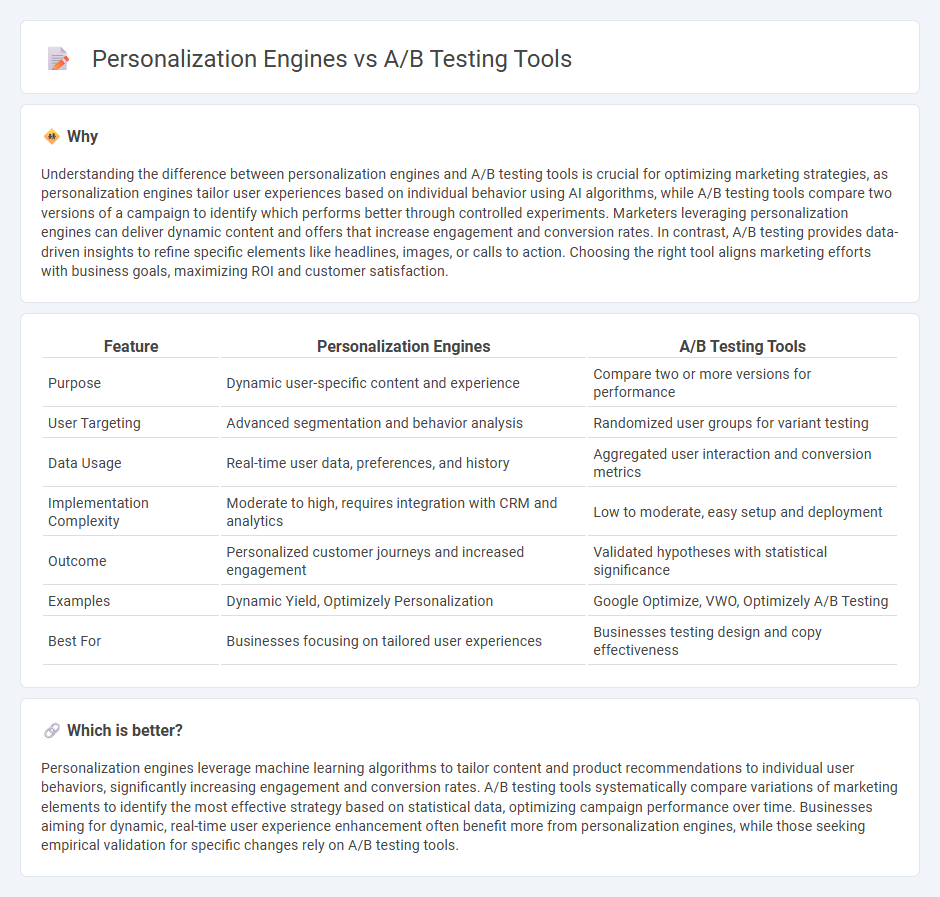
Personalization engines leverage machine learning algorithms to tailor marketing content to individual user behaviors and preferences, enhancing customer engagement and conversion rates. A/B testing tools systematically compare different versions of marketing assets to identify the most effective elements based on user response metrics. Explore the nuances of personalization engines and A/B testing tools to optimize your marketing strategy effectively.
Why it is important
Understanding the difference between personalization engines and A/B testing tools is crucial for optimizing marketing strategies, as personalization engines tailor user experiences based on individual behavior using AI algorithms, while A/B testing tools compare two versions of a campaign to identify which performs better through controlled experiments. Marketers leveraging personalization engines can deliver dynamic content and offers that increase engagement and conversion rates. In contrast, A/B testing provides data-driven insights to refine specific elements like headlines, images, or calls to action. Choosing the right tool aligns marketing efforts with business goals, maximizing ROI and customer satisfaction.
Comparison Table
| Feature | Personalization Engines | A/B Testing Tools |
|---|---|---|
| Purpose | Dynamic user-specific content and experience | Compare two or more versions for performance |
| User Targeting | Advanced segmentation and behavior analysis | Randomized user groups for variant testing |
| Data Usage | Real-time user data, preferences, and history | Aggregated user interaction and conversion metrics |
| Implementation Complexity | Moderate to high, requires integration with CRM and analytics | Low to moderate, easy setup and deployment |
| Outcome | Personalized customer journeys and increased engagement | Validated hypotheses with statistical significance |
| Examples | Dynamic Yield, Optimizely Personalization | Google Optimize, VWO, Optimizely A/B Testing |
| Best For | Businesses focusing on tailored user experiences | Businesses testing design and copy effectiveness |
Which is better?
Personalization engines leverage machine learning algorithms to tailor content and product recommendations to individual user behaviors, significantly increasing engagement and conversion rates. A/B testing tools systematically compare variations of marketing elements to identify the most effective strategy based on statistical data, optimizing campaign performance over time. Businesses aiming for dynamic, real-time user experience enhancement often benefit more from personalization engines, while those seeking empirical validation for specific changes rely on A/B testing tools.
Connection
Personalization engines leverage A/B testing tools to optimize user experiences by analyzing variations of content and user interactions. These tools enable marketers to measure the effectiveness of personalized elements, such as targeted messages or product recommendations, by comparing different versions to identify the highest performing options. Integrating A/B testing with personalization engines enhances marketing strategies by delivering data-driven, tailored campaigns that increase engagement and conversion rates.
Key Terms
Experimentation Platforms
Experimentation platforms like Optimizely and VWO offer robust A/B testing tools designed to optimize user experience through data-driven insights and multivariate testing capabilities. Personalization engines such as Dynamic Yield and Evergage leverage machine learning algorithms to deliver tailored content and real-time user segmentation. Explore the distinct advantages of these experimentation platforms to elevate your digital optimization strategy.
Segmentation Algorithms
Segmentation algorithms in A/B testing tools primarily divide users into distinct groups to measure specific variant performances, often relying on basic demographic or behavioral data. Personalization engines utilize advanced segmentation techniques, such as machine learning models and real-time data analysis, to dynamically tailor content for individual user profiles, enhancing engagement and conversion rates. Explore how these segmentation approaches impact marketing strategies and drive user experience optimization.
Dynamic Content Delivery
A/B testing tools enable marketers to compare different versions of content by segmenting audiences and analyzing performance metrics, optimizing static variations. Personalization engines leverage real-time data and AI algorithms to dynamically deliver individualized content, enhancing user engagement through tailored experiences. Explore how combining both approaches can transform your dynamic content delivery strategies for higher conversion rates.
Source and External Links
Unbounce's 16 Best A/B Testing Tools - Provides a comprehensive list of A/B testing tools, including Statsig, Optimizely, and VWO.
Contentsquare's 7 Best A/B Testing Tools - Offers tools like VWO, Omniconvert, and Crazy Egg for effective A/B testing.
VWO's 15 Best A/B Testing Tools - Lists top tools including VWO, Optimizely, and AB Tasty for optimal A/B testing.
WPForms' Best WordPress A/B Testing Plugins - Features Thrive Optimize and OptinMonster as top choices for WordPress A/B testing.
Statsig - Designed for developers and product teams, offering A/B testing, feature flags, and data analysis.
Kameleoon - Offers real-time A/B testing capabilities for web and full-stack applications.
Optimizely - Provides comprehensive web experimentation tools with advanced features for complex tests.
Crazy Egg - Utilizes heat maps and user recordings to analyze user behavior on websites.
AB Tasty - Offers robust web optimization and A/B testing capabilities for enhancing user experience.
 dowidth.com
dowidth.com